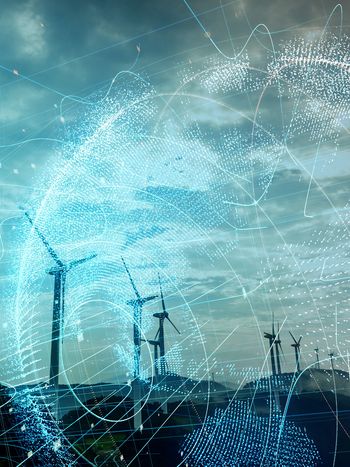Augmented & Virtual reality & XR, Future of Electric power utilities O&M
Virtual reality technology (VR) refers to a kind of computer simulation system, which can emulate reality in the form of a virtual world that can be interacted by users. It uses a computer to generate a virtual environment in which users can immerse themselves in an artificial environment. Virtual reality technology involves using real-life data, through the electronic signal generated by computer technology, and combining it with various output devices, so that it can be transformed into phenomena that people can feel. These phenomena can be real objects or elements we cannot see with the naked eyes, which can be expressed by a three-dimensional model. Because these phenomena are not what we can see directly in the real world but are simulated by computer technology, this technology is the so-called virtual reality.


WG D2.49 Convenor
Augmented reality (AR) is a technology that superimposes virtual information on the physical reality world, which can be perceived by people in many ways, such as seeing, listening, touching, etc. There are many kinds of virtual information, which can be two-dimensional plane label, three-dimensional object structure and three-dimensional surrounding audio signal. Virtual information is triggered and displayed according to certain rules, and the interaction is realized through human-computer interaction.
Virtual Reality (VR) technology can allow full immersive scenarios, representing the real activity based on a 3D computer simulation. On the other hand, AR is the technology that superimposes virtual objects over the real environment in which the user is immersed through smartphones, tablets, PC, or connected glasses. Therefore, VR combines real and virtual object in a unite space. In a VR application, there is a total virtual scenario representation, which can be a full user immersion or a semi-immersive case inside a dedicated room. In a virtual environment, the user dives into a parallel word, where he is able to have real senses with virtual representation. The AR may benefit investor-owned, municipal and cooperative utilities in improving business processes. It can for instance speed up power restoration or help address the challenge of an aging, retiring utility workforce by facilitating the preservation of institutional knowledge.
In traditional power operation and maintenance process, operators often encounter problems such as complex equipment, high responsibility, inconvenient operation, limited on-site help seeking, cumbersome data search, and inability of the command center to see the status of each operation site in real time. At present, AR and VR technologies can be applied to multiple parts of complex power utility business processes:
1. AR/XR technology training:
a qualified operator needs a long time of technical training; AR technology can speed up the process. In the training station, the information is plotted on the real equipment, which can show the three-dimensional model and internal structure of the equipment to understand the working principle. After an augmented reality training, the operators are feeling more comfortable with working mode in the actual work process.
2. AR equipment inspection:
there is much equipment in substations, data centers and other places. By wearing an augmented reality industrial intelligent helmet, inspectors can check the equipment status according to the inspection sequence based on the registration tracking technology of SLAM (Simulation Localization and Mapping). This technology relies on system for precise segmentation, tracing and registering of images. For each inspection item, they can view sensor data historical trend, status evaluation results and other virtual information fused on the physical entity and uses the human-computer interaction information to complete the inspection information real-time reporting. It can help inspectors to master the status of equipment more comprehensively and intuitively and improve the efficiency of inspection work.
3. AR equipment installation:
In the case of complex connection between devices, the installation personnel often need to spend a lot of time looking for the corresponding interface. Using augmented reality technology, the virtual information such as interface mode and connection relationship is tracked and located on the equipment. The installation personnel can quickly complete the docking and installation of devices and equipment according to the guidance information.
4. AR visual safety operation:
Using AR technology, electronic fence can be used for safety warning in electric power operation site, and SLAM is used for visual warning of dangers in high voltage and high-altitude operation sites, so that operators wearing industrial intelligent helmets can always keep vigilance.
5. VR power engineering design:
Using VR technology, users can carry out in-depth and intuitive communication on a design by wearing intelligent glasses and other terminal devices and using gesture recognition interaction mode, and can also replace and adjust working mode. In this way, the participants' cognition and understanding of the scheme are no longer limited to plane drawings, and the final adjustments are solidified in the existing model, avoiding the differences in perception among the participants. It’s easy to imagine a time when immersive technologies compete on equal terms with a traditional approach of paper-based asset records and boots on the ground planning.
Utility systems expand and evolve because of many factors. Climate change and the move to renewable energy sources, population growth, and the adoption of electric vehicles have and will put new demands upon transmission and distribution systems. Utilities operators are not inclined to update asset records within an asset lifespan. Until this time the benefits are likely to be restricted to new build infrastructure. At the point at which it has expanded to most of the system, then the real benefits of AR and VR should start to flow. A fully integrated system with embedded sensors to reduce diagnostic time and remote inspection tools is probably still a long way away for many system operators. It will take many incremental steps to reach a plateau that is already technically achievable, but costly to implement. This should not prevent adoption. Many of these incremental steps will have significant benefits in themselves.
AR/VR/XR technology advantages and disadvantages can be summarized in the table below:
| Advantages | Disadvantages |
|---|---|
Remote support and hands-free working | Provision of adequate training and upskilling in the use of new technology, often within the shadow of an ageing workforce |
| Visual warning of dangers in high voltage and high altitude operation sites | Expensive training in the use of a package |
| Reducing diagnostic time and remote inspection tools | VR headset is not something we can wear for hours |
| Visual safety operation | What you see when you use AR/VR is rarely as pretty as what you see in real life |
| Quick completion of the docking and installation of devices and equipment according to the guidance information | We cannot see the real world around us to do little but important things |
| High quality and fast training method for workers | AR/VR are not equipped well to some functions such as eye tracking |
| Help inspectors to master the status of equipment more comprehensively and intuitively |
Our Working Group WG D2.49 in CIGRE would like to help utilities to expand the use of AR and VR in the domain or operation and maintenance. A common challenge for all companies is the successful development of a business case for capital expenditure, thoroughly capturing both primary and secondary benefits to justify the upfront cost of implementation. Whilst many application cases for AR and VR focus upon remote support and hands-free working, this is often not enough to breach the barrier for adoption. Other subtler benefits need to be both understood and quantified to add further value to the application case. The proposed future publications for this WG, including the technical brochure and tutorial will aid in this regard. The technical brochure will provide best practice examples of systems that have already been adopted by system operators, contractors and the wider industry whilst the tutorials will draw together some of these secondary benefits of adoption.
Illustration credits:
Banner by SasinParaksa on iStock
Thumbnail by Minh Pham on Unsplash

